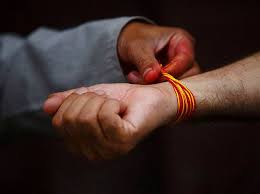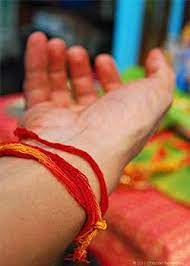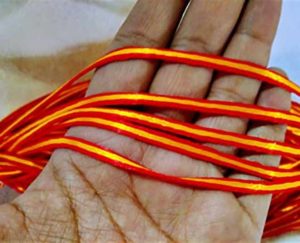
17:55
Let us first understand, what does Mauli or Kalava mean? The literal meaning of Mauli in Sanskrit is ‘crown’, which means above all. Well, Mauli is a sanctified thread which is also known as ‘Kalava’. This thread is dyed in red and yellow combination.
A Mauli is tied during or after a religious ceremony by a priest or an elder in the family. The proper way of tying it on your wrist is by spinning it seven times then three knots are tied on the devotee’s hand while the palm is facing upwards.
Also, a Mauli is offered to a deity for some positive vibes and to be protected from the evil eye. Along with the way of tying Mauli, the day is also essential. You should tie a Mauli on a Tuesday or a Saturday or any other religious event.
In India, Mauli holds great significance and has different names all over the country like Kalava, Rakshastra, Charadu and many more. These threads are a representation of long life and protection against evil. Read on to know all about Mauli along with its religious and scientific significance.
Mauli holds tremendous significance in Hindu culture since ancient times. As mentioned above the literal meaning of Mauli is the crown, a crown is always placed above. Lord Shiva is referred as ‘Chandramauli’ as he adornes the crescent moon on his matted hair.
According to the ancient Hindu scriptures, it is said that Lord Vishnu’s incarnation Vamana tied the ‘Raksha (protection) Dhaga (Thread)’ on the wrist of King Bali to grant him with the boon of immortality. Since then, the ritual of tying Mauli has been practiced by the Hindu sect.
Every Hindu ritual has a story and significance to back it. The sanctified thread is tied by the Guru/ panditji (holy men) or by the elderly members, especially grandparents of the family on the wrist of each person who is present in the holy ceremony.
While tying the Mauli, a mantra is chanted, it is believed that, reciting the sacred mantras is done to infuse the thread with positivity and invoke the Sattvik (pure) state in humans.
The ‘Ardhanarishvara’ form of Shiva and Parvati has been depicted as right half Shiva and the left half is Parvati Devi. Hence, men are tied Mauli on right wrist while female are tied Mauli on the left wrist. A lot of attributes are associated with Mauli, it is known as the protection shield which keeps the evil/ negative energies and worldly problems at bay. Mauli is also tied to receive blessings from the deity who is worshipped during the puja (prayer) ceremony or havan (Holy fire).
Scientific significance of tying a Mauli: Almost all the important veins pass on to the other parts of the body from wrist only. In Ayurveda, there is a theory called as the ‘Tridosha Theory’. According to this theory, our body constitutes of three Dosha (Fault) namely Vaat (Wind), Pitt (Bile) and Kaptha (Phlegm).
The red thread known as Mauli or Kalava is a sacred thread tied on the wrist before the start of any Hindu sacred ceremony. … So if we tie Mouli on the wrist, it helps in controlling the blood circulation of the body. Wearing Kalava in hand to ward off negative energy or evil spirits.
Aforementioned, Mauli holds a high level of importance in the Hindu religion. It is an essential factor in allowing them to convey their faith and beliefs. However, Mauli not only has a religious significance but also has a scientific logic behind it. Read ahead to know more.
If a small amount of weight is placed on the wrist it activates the nerve centers in that area. Thus, when Mauli is tied around the wrist it activates the nerves center and helps in improving the blood circulation which balances the Tridoshas.
It also helps in keeping the negative energies away from our aura and acts like a protecting shield.

A Mauli is tied during or after a religious ceremony by a priest or an elder in the family. The proper way of tying it on your wrist is by spinning it seven times then three knots are tied on the devotee’s hand while the palm is facing upwards. The thread of Mauli tied on right arm
Also, a Mauli is offered to a deity for some positive vibes and to be protected from the evil eye. Along with the way of tying Mauli, the day is also essential. You should tie a Mauli on a Tuesday or a Saturday or any other religious event.
Mauli threads are known to keep us protected from several dangers including any kind of negative energy and diseases. They help us to receive blessings from our deity and add positive energy to our lives.
Mauli threads are known to keep us protected from several dangers including any kind of negative energy and diseases. They help us to receive blessings from our deity and add positive energy to our lives. Rakhi tied on a brother’s hands by her sister on the festival of Rakshabandhan is also a type of Mauli.
Mauli has several mentions and references in the mythology. Read ahead to know all about these references.

Apart from the religious significance, Mauli threads also have a scientific significance. In Ayurveda, there are three faults in our body, Vatta, Pitta and Kapha which are also known as the Tridoshas. The instability of these doshas can lead to harmful results.
Putting some weight on our wrists with a Mauli ensures that there are no imbalances in these doshas. Thus, it protects us from several harmful diseases like diabetes, heart disease and many more along with this enhances blood circulation.
“Om yena baddho balee raajaa daana
vendro mahaa balah tenatvaa mabhibadhnaami,
rakshe maachala maachala”.
The meaning of this mantra is “I am tying this thread on your hand this is a symbol of Raksha (protection), with which the most powerful and generous King Bali himself was bound; O Raksha, don’t go away; don’t go away.”
It is believed that, reciting the sacred mantras is done to infuse the thread with positivity and invoke the Sattvik (pure) state in humans. It protects the wearer from all negativities and evil influences; it also wards off dangers, diseases and enemies.
The ‘Ardhanarishvara’ form of Shiva and Parvati has been depicted as half and half woman. The iconographic attributes depict the right half as Shiva and the left half is Parvati Devi. This generates the Universal Protective Shield in form of energy known as Purusha and Prakriti. The classic example of this would be: The idol of of God in any temple is placed on the right whereas; the idol of the Goddess is placed on the left. Hence, men are tied Mauli on right wrist while female are tied Mauli on the left wrist.
It is believed that by tying the Mauli, blessing from Tridev- Brahma, Vishnu and Mahesh and Tridevi- Lakshmi, Saraswati and Durga; are bestowed upon the devotee. We get fame from the blessing of Brahma, from the blessings of Lord Vishnu we get power to defend the evil and from the blessings of Supreme Shiva we get the power to end all are negative qualities. On the other hand, we receive knowledge from the blessings of Goddess Saraswati, from the blessings of Goddess Lakshmi we get prosperity and from blessings of Goddess Durga we get power. A lot of attributes are associated with Mauli, it is known as the protection shield which keeps the evil/ negative energies and worldly problems at bay. Mauli is also tied to receive blessings from the deity who is worshipped during the puja (prayer) ceremony or havan (Holy fire).
In the scripture of Mahabharata too a very important significance of Mauli is presented. During a war, Kunti tied red thread (Mauli) on right hand wrist of Abhimanyu as a shield of protection. None of the warriors could defeat Abhimanyu. It was only when a mouse nibbled off the thread that his protection went away and he was killed.
Now that we know its religious significance, let us understand the scientific significance of tying a Mauli. We all know that our body constitutes of 72,000 nerves. Almost all the important veins pass on to the other parts of the body from wrist only. In Ayurveda, there is a theory called as the ‘Tridosha Theory’. According to this theory, our body constitutes of three Dosha (Fault) namely Vaat (Wind), Pitt (Bile) and Kaptha (Phlegm) s. These three bio-elements are very unstable. If a small amount of weight is placed on the wrist it activates the nerve centers in that area. Thus, when Mauli is tied around the wrist it activates the nerves center and helps in improving the blood circulation which balances the Tridoshas. It also helps in keeping the negative energies away from our aura and acts like a protecting shield.
I hope you enjoyed this read and this article answered all your queries about the sacred thread ’Mauli’. If you liked this article do post your comments to us in the space provided in the comment box or like this article.
If you liked this article or want to share some information with us then do write us in the comment section below. You can drop your queries on 9152203064 or on [email protected] . For more such updates do like our page @jaymahakaal01 and keep visiting www.jaymahakaal.com
Copyright © 2024 Jay Mahakaal Centre of Occult Science Pvt Ltd All Rights Reserved